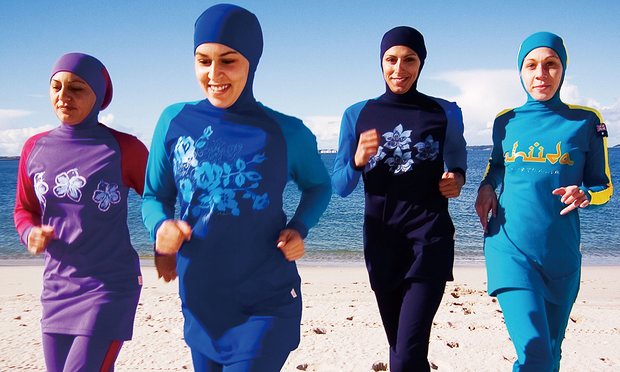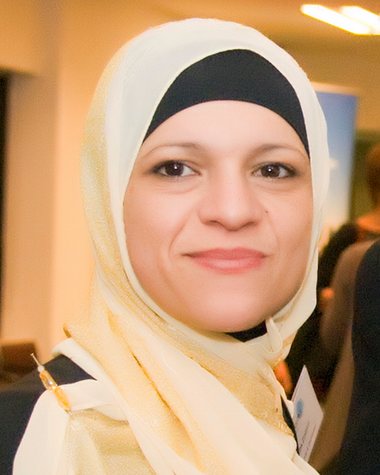I Created the Burkini to Give Women Freedom, Not to Take It Away
SPOTLIGHT, 29 Aug 2016
The burkini does not symbolise Islam, it symbolises leisure and happiness and fitness and health. So who is better, the Taliban or French politicians?

‘I would love to be in France to say this: you have misunderstood. And there are more problems in the world to worry about; why create more?’ Photograph: Aheda Zanetti
24 Aug 2016 – When I invented the burkini in early 2004, it was to give women freedom, not to take it away. My niece wanted to play netball but it was a bit of a struggle to get her in the team – she was wearing a hijab. My sister had to fight for her daughter to play, had to debate the issue and ask, why is this girl prevented from playing netball because of her modesty?
When she was finally allowed to play we all went to watch her to support her and what she was wearing was totally inappropriate for a sports uniform – a skivvy, tracksuit pants, and her hijab, totally unsuitable for any type of sport. She looked like a tomato she was so red and hot!
So I went home and went looking for something that might be better for her to wear, sportswear for Muslim girls, and I couldn’t find anything, I knew there was nothing in Australia. It got me thinking because when I was a girl I missed out on sport – we didn’t participate in anything because we chose to be modest, but for my niece I wanted to find something that would adapt to the Australian lifestyle and western clothing but at the same time fulfil the needs of a Muslim girl.
So I sat down on my lounge room floor and designed something. I looked at the veil and took away a lot of the excess fabric, which made me nervous – would my Islamic community accept this? The veil is supposed to cover your hair and your shape, you just don’t shape anything around your body. But this was shaped around the neck. I thought, it’s only the shape of a neck, it doesn’t really matter.
Before I launched it I produced a sample with a questionnaire to find out what people would think – would you wear this? Would this encourage you to be more active? Play more sport? Swim? A lot of people in my community didn’t know how to accept this, but I developed it commercially and made a good business.
The burkini came to everyone’s attention when Surf Lifesaving Australia introduced a program to integrate Muslim boys and girls into surf lifesaving after the Cronulla riots – they had a young Muslim girl who wanted to compete in an event. She wore a burkini.
After September 11, the Cronulla riots, the banning of the veil in France, and the international backlash that came with it – about us being the bad people all because of a few criminals who do not speak on behalf of Muslims – I really didn’t want anyone to judge girls wearing these. It’s only a girl being modest.
It was about integration and acceptance and being equal and about not being judged. It was difficult for us at the time, the Muslim community, they had a fear of stepping out. They had fear of going to public pools and beaches and so forth, and I wanted girls to have the confidence to continue a good life. Sport is so important, and we are Australian! I wanted to do something positive – and anyone can wear this, Christian, Jewish, Hindus. It’s just a garment to suit a modest person, or someone who has skin cancer, or a new mother who doesn’t want to wear a bikini, it’s not symbolising Islam.
When I named it the burkini I didn’t really think it was a burqa for the beach. Burqa was just a word for me – I’d been brought up in Australia all my life, and I’d designed this swimsuit and I had to call it something quickly. It was the combination of two cultures – we’re Australians but we are also Muslim by choice. The burqa doesn’t symbolise anything here, and it’s not mentioned in the Qur’an and our religion does not ask us to cover our faces, it’s the wearer’s choice to do so. Burqa is nowhere in any Islamic text. I had to look the word up, and it was described as a kind of coat and cover-all, and at the other end you had the bikini, so I combined the two.
This negativity that is happening now and what is happening in France makes me so sad. I hope it’s not because of racism. I think they have misunderstood a garment that is so positive – it symbolises leisure and happiness and fun and fitness and health and now they are demanding women get off the beach and back into their kitchens?
This has given women freedom, and they want to take that freedom away? So who is better, the Taliban or French politicians? They are as bad as each other.
I don’t think any man should worry about how women are dressing – no one is forcing us, it’s a woman’s choice. What you see is our choice. Do I call myself a feminist? Yes, maybe. I like to stand behind my man, but I am the engine, and I choose to be. I want him to take all the credit, but I am the quiet achiever.
I would love to be in France to say this: you have misunderstood. And there more problems in the world to worry about, why create more? You’ve taken a product that symbolised happiness and joyfulness and fitness, and turned it into a product of hatred.
Also, what are the French values? What do you mean it doesn’t combine with French values, what does that mean? Liberty? You telling us what to wear, you telling us what not to do will drive women back into their homes – what do you want us to do then? There will be a backlash. If you are dividing the nation and not listening and not working towards something you are naturally going to have someone who is going to get angry. If you are pushing people away, and isolating them – this is definitely not a good thing for any politician to do, in any country.
I remember when I first tested the burkini. First I tested it in my bathtub, I had to make sure it worked. Then I had to test it by diving in it, so I went to the local pool to test that the headband would stay put, so I went to Roselands Pool, and I remember that everyone was staring at me – what was I wearing? I went right to the end of the pool and got on the diving board and dived in. The headband stayed in place, and I thought, beauty! Perfect!
It was my first time swimming in public and it was absolutely beautiful. I remember the feeling so clearly. I felt freedom, I felt empowerment, I felt like I owned the pool. I walked to the end of that pool with my shoulders back.
Diving into water is one of the best feelings in the world. And you know what? I wear a bikini under my burkini. I’ve got the best of both worlds.
____________________________________
Aheda Zanetti is the creator and manufacturer of the burkini.
Go to Original – theguardian.com
DISCLAIMER: The statements, views and opinions expressed in pieces republished here are solely those of the authors and do not necessarily represent those of TMS. In accordance with title 17 U.S.C. section 107, this material is distributed without profit to those who have expressed a prior interest in receiving the included information for research and educational purposes. TMS has no affiliation whatsoever with the originator of this article nor is TMS endorsed or sponsored by the originator. “GO TO ORIGINAL” links are provided as a convenience to our readers and allow for verification of authenticity. However, as originating pages are often updated by their originating host sites, the versions posted may not match the versions our readers view when clicking the “GO TO ORIGINAL” links. This site contains copyrighted material the use of which has not always been specifically authorized by the copyright owner. We are making such material available in our efforts to advance understanding of environmental, political, human rights, economic, democracy, scientific, and social justice issues, etc. We believe this constitutes a ‘fair use’ of any such copyrighted material as provided for in section 107 of the US Copyright Law. In accordance with Title 17 U.S.C. Section 107, the material on this site is distributed without profit to those who have expressed a prior interest in receiving the included information for research and educational purposes. For more information go to: http://www.law.cornell.edu/uscode/17/107.shtml. If you wish to use copyrighted material from this site for purposes of your own that go beyond ‘fair use’, you must obtain permission from the copyright owner.

Great article! I am an Australian now living in “secular France” and am glad the Court has decided the local Mayors overstepped their authority in banning the sensible use of Burkinis.
btw I have very sensitive skin and avoid the sun where possible, having psoriasis and also having lost friends to melanoma in Australia. Many children’s swimsuits in Australia are protective and cover a lot of the body-who objects to keeping kids safe?
All the best to Aheda!!